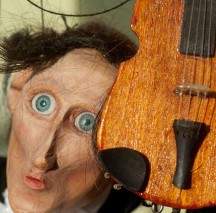
As generations of Italian-Americans pass away, with them go the traditions that may never be replicated again. One tradition which struggles to survive is the Marionette theater that the Italian immigrants brought over with them from places such as Naples, Rome, Palermo and Catania. Puppet theaters inspired by the Italian tradition live in Brooklyn, Glover, Vermont and New Orleans.
Though the origin of the marionette theater is unknown, there is evidence that wooden religious figures were used in Roman theaters to present social, moral and political problems of the day. The Romans had “bread and circus” for the masses. Vermont has the Bread and Puppet Theater, which has existed since the Viet Nam War and like the Romans is fond of satirical plays that poke fun at political figures.
Politics was not the theme of plays in the Middle Ages. Marionette theater programs were used by the Church as a means to teach the illiterate faithful the tenets of Catholicism. Across the Straits of Messina, the island of Sicily was ruled by the Normans. The themes performed by their marionettes were gleaned from the history – such as the story of Charlemagne based on famous French poem La Chanson de Roland (let’s not forget that the Normans were French). Other medieval epics that inspired the playwrights of the puppet theaters were Orlando Furioso, Orlando Innamorato, and Gerusalemme Liberata (Jerusalem Liberated). Characters portrayed scheming royals, fighting Normans and Muslims, witches, nuns and bishops. Each story was full of sorcery, fire-breathing dragons, the ritual rescue of damsels in distress and lots of gore.
Catania and Palermo both had marionette theaters and the rivalry between them was fierce. Each worked toward perfecting their wooden puppets. There were three main types of puppets: rod puppet, shadow puppets and large scale marionettes. Palermo’s puppets had knees that could be bent and a sword that could be extracted and returned to its sheath. Catanian dummies were larger and did not have limbs that could be bent. The size of the puppet was based on their role in society, with the Emperor being the tallest and having the most elaborate outfit and the peasants the smallest with least adorned garb. Their costumes were authentic, colorful and diverse, having velvet cloaks, feathers, and elegance when warranted. Knights had armor made of copper or light steel, heraldic designs, spangles and fringe. Their heads were covered in human hair.
The puppeteers had to be big and brawny; considering they had to work the limbs of wooden puppets five feet tall throughout a play that would last at least two hours! They also had to be master actors, for they projected their voices to portray multiple roles in the play: royalty, Christians, Moors, Emperors, Kings, villagers and peasants, dragons, sorcerers, to just name a few. Imagine having to move from puppet to puppet and keep the story going…
Southern Italians, in particular Sicilians, brought with them to the large cities of United States the folkloric tradition of the marionette theater. Two noted families, the Agrippinos and the Manteos, came to New York’s Lower East Side with over eighty marionettes, while the rest of their puppets, estimated to be over two hundred, came over little by little. These life size marionettes performed nightly for the tired and lonely immigrants. Watching the figures in action enabled them to forget the hard labor, the indignities, and the loneliness of being in a new land without their loved ones. It was not unusual for a play to have a couple of hundred episodes so the story would last the entire year long. Patrons would come back night after night, fascinated by stories set hundreds of years earlier and whose protagonists might be Emperor Frederick II Hohenstaufen, Charlemagne, or the Arab Sheiks.
Eventually, the Manteo Family Sicilian Marionetter Theater was established in Staten Island, but with the death of Michael Manteo in 1989 the shows no longer exist. Some of Manteo’s puppets had been exhibited the Corcoran Gallery in Washington and Copper-Hewitt Museum in New York – but that was thirty years ago.
The Italian tradition of il teatro dei pupi does shine on Sixth Avenue in Brooklyn, NY. Puppet Works Inc. provides a venue for local puppeteers to perform. They also provide engaging plays such as Beauty and the Beast, The Wizard of Oz, Goldilocks and The Three Bears (just to name a few). They cross the Hudson River to New Jersey and also perform in Jersey City.
One locale where Sicilian immigrants and their puppets landed since the late 1800s is New Orleans. The Mudlark Public Theater and its puppet shows are so enormously popular they have general audience shows (Puss and Boots) and Adult Only shows (one can only surmise they are rated X.) The Mudlark Public Theater, which has an extensive puppet collection, hosts the International Puppet Festival every April with international puppeteers in attendance. Italian master Remo Di Filippo opened up the festival with “Hanging on a Thread.” Each of Di Filippo’s seven puppets portrayed stories and situation that were described as “moving, poetic and surreal.”.
Another festival worth noting is the one held in Sicily. The Festival of the Sicilian Marionettes in Palermo is held each November. The latest show features puppeteers from Italy, Japan, Spain, France, Israel and Viet Nam. In the United States, the master puppeteers Emanuele Macri and Michael Manteo and their life-size marionettes that performed on Mulberry Street in Little Italy no longer exist. We must htherefore be thankful for Palermo, New Orleans, Brooklyn, and Glover, Vermont for promoting the art of puppetry and for keeping il teatro dei pupi from becoming extinct in Italy and the United States.
